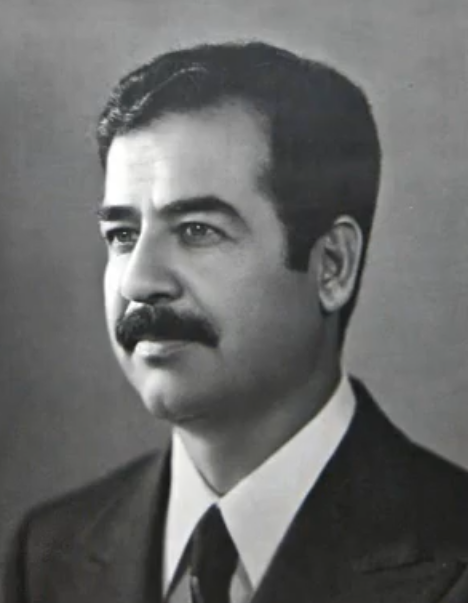An overview of the childhood and early education of Saddam Hussein, highlighting the experiences that shaped the journey.
Saddam Hussein was the fifth president of Iraq from 1979 to 2003, following the American invasion. He was a key member of the Arab Socialist Ba'ath Party and advocated for Ba'athism, blending Arab nationalism and socialism. His political ideology is known as Saddamism. He previously served as Vice President (1968-1979) and Prime Minister (1979-1991, 1994-2003). His rule ended with his overthrow and subsequent capture.
April 1937: Saddam Hussein's Birth
In April 1937, Saddam Hussein was born in al-Awja, near Tikrit, to a Sunni Arab family.
1941: Anglo-Iraqi War
In 1941, Saddam Hussein's father-in-law, Khairallah Talfah, fought against Great Britain in the Anglo-Iraqi War.
1955: Ba'ath Party Membership
In 1955, there were fewer than 300 Ba'ath Party members in Iraq, marking the early stages of Saddam Hussein's involvement with the party.
1956: Suez Crisis
In 1956, the Suez Crisis occurred, influencing young Ba'athists like Saddam Hussein with the pan-Arab nationalism of Gamal Abdel Nasser.
1957: Joined the Ba'ath Party
In 1957, Saddam Hussein joined the revolutionary Ba'ath Party, marking the beginning of his political career.
1957: Dropped out of Law School to Join Ba'ath Party
In 1957, at the age of 20, Saddam Hussein dropped out of an Iraqi law school to join the revolutionary pan-Arab Ba'ath Party.
October 1959: Assassination Attempt on Qasim
In October 1959, Saddam Hussein participated in the Ba'ath Party's assassination attempt on Qasim, though the attempt failed.
1959: Aftermath of Assassination Attempt on Qasim
In 1959, following the failed assassination attempt on Qasim, Saddam Hussein's biography highlights his fearlessness, loyalty, and resourcefulness in saving his comrades and escaping.
February 1960: Escape to Egypt
In February 1960, Saddam Hussein escaped to Egypt via Syria, finding refuge under Nasser's protection after the failed assassination attempt on Qasim.
1961: Graduation from High School
In 1961, while in exile in Egypt, Saddam Hussein graduated from high school.
1962: Pursued Law Degree
In 1962, Saddam Hussein started pursuing a law degree at Cairo Law School, which he continued until 1963.
February 1963: Ramadan Revolution Coup
In February 1963, the Ba'ath Party overthrew and killed Qasim in the Ramadan Revolution coup. Saddam Hussein was in exile in Egypt at the time.
November 1963: Anti-Ba'athist Coup
In November 1963, Abdul Salam Arif dismissed and arrested Ba'athist leaders in a coup, while Saddam Hussein was in exile in Egypt.
1963: End of Exile in Egypt
In 1963, Saddam Hussein's exile in Egypt came to an end, after he had pursued a law degree at Cairo Law School from 1962-1963.
October 1964: Arrest and Imprisonment
In October 1964, Saddam Hussein was arrested and imprisoned for approximately two years for planning to assassinate Arif.
September 1966: Challenge to Syrian Domination
In September 1966, Saddam Hussein initiated a challenge to Syrian domination of the Ba'ath Party, leading to the party's formal split into two factions.
July 1968: Participation in a Bloodless Coup
In July 1968, Saddam Hussein participated in a bloodless coup led by Ahmed Hassan al-Bakr that overthrew Abdul Rahman Arif, marking a significant event in his rise to power.
1979: Purge of Rivals
In 1979, after taking office as president, Saddam Hussein purged rivals within his party, consolidating his power.
July 1988: Iran Accepts Resolution 598
On 20 July 1988, Iran accepted Resolution 598 of the United Nations Security Council. This acceptance was largely influenced by diminished morale, economic hardship, and the success of Iraq's Tawakalna ala Allah Operations, paving the way for a ceasefire in the Iran-Iraq War.
August 1988: Ceasefire Accepted
On 20 August 1988, Iran accepted Resolution 598, signaling a ceasefire, primarily due to a combination of factors including poor morale, economic collapse, and the success of Iraq's Tawakalna ala Allah Operations. This brought the Iran-Iraq war to an end after years of hostilities.
August 1990: Invasion of Kuwait
On 2 August 1990, Saddam Hussein invaded Kuwait, initially claiming to assist Kuwaiti revolutionaries, triggering an international crisis. By 28 August, Kuwait was formally declared the 19th Governorate of Iraq.
1990: Economic Decline Due to Sanctions
In 1990, following the invasion of Kuwait and the imposition of United Nations sanctions, Iraq's GDP plummeted from US$44.36 billion in 1990 to US$9 billion by 1995 due to blocked Iraqi oil exports. The sanctions also restricted basic medical equipment and supplies from getting into Iraq.
January 1991: Start of Operation Desert Storm
On 16 January 1991, a U.S.-led coalition launched round-the-clock missile and aerial attacks on Iraq. This operation was backed by the Security Council and aimed to liberate Kuwait.
February 1991: Ejection from Kuwait
In February 1991, a ground force consisting largely of U.S. and British armored and infantry divisions ejected Saddam's army from Kuwait, occupying the southern portion of Iraq as far as the Euphrates.
1992: Initial Offer of the Oil-for-Food Programme
In 1992, The United Nations initially offered the Oil-for-Food Programme to Iraq, which Saddam Hussein's government accepted on 9 December 1996.
1993: Initiation of the Faith Campaign
In 1993, Saddam Hussein initiated the Faith Campaign under the supervision of vice president Izzat Ibrahim al-Douri to gain support from religious communities. Some elements of Sharia law were introduced, and the phrase "Allahu Akbar" was added to the national flag in Saddam's handwriting.
August 1995: Raghad and Rana defect to Jordan
In August 1995, Saddam Hussein's daughters, Raghad and Rana, along with their husbands, Hussein Kamel al-Majid and Saddam Kamel al-Majid, defected to Jordan with their children.
1995: Continued Economic Hardship Under Sanctions
By 1995, Iraq's GDP had plummeted to US$9 billion due to the UN sanctions imposed after the invasion of Kuwait in 1990. Iraq had lost around US$170 billion of oil revenues, and the sanctions restricted basic-medical equipment and supplies from getting into Iraq.
February 1996: Kamel brothers killed after return to Iraq
In February 1996, the Kamel brothers were killed in a gunfight with clan members, just three days after returning to Iraq following assurances of a pardon from Saddam Hussein.
December 1996: Acceptance of the Oil-for-Food Programme
On 9 December 1996, Saddam Hussein's government accepted the Oil-for-Food Programme offered by the UN in 1992. This program was designed to ease the economic hardship caused by UN sanctions, which had significantly reduced Iraq's GDP since 1990.
2000: Improved Iraqi Economy and Diplomatic Relations
By 2000, Iraq's diplomatic isolation with Arab states was diminishing, and the Iraqi economy improved, with its GDP increasing to $23.73 billion.
April 2001: Saddam's 64th birthday celebration
On April 28, 2001, Saddam Hussein marked his 64th birthday with a large, state-sponsored celebration.
April 2003: Uncertainty Regarding Saddam's Whereabouts
In April 2003, following the fall of Baghdad, Saddam Hussein's whereabouts were unknown. He released audio tapes promoting popular resistance to his ousting.
July 2003: Deaths of Uday and Qusay Hussein
On 22 July 2003, Saddam Hussein's sons, Uday and Qusay, and his 14-year-old grandson Mustafa, were killed in a gunfight with U.S. forces in Mosul. He commemorated them as "martyrs" on radio.
December 2003: Capture of Saddam Hussein in Operation Red Dawn
On 13 December 2003, Saddam Hussein was captured by American forces in Operation Red Dawn, found hiding in a hole near ad-Dawr, near Tikrit. US administrator Paul Bremer confirmed the capture on 14 December and presented video footage of Saddam in custody.
2003: Overthrow After American Invasion
In 2003, Saddam Hussein was overthrown following the American invasion of Iraq, ending his presidency.
June 2004: Transfer of Saddam to Interim Iraqi Government Custody
On 30 June 2004, Saddam Hussein, along with 11 other senior Ba'athist leaders, was transferred from US custody at Camp Cropper to the interim Iraqi government to stand trial for crimes against humanity and other offences.
December 2006: Saddam Hussein's Death
In December 2006, Saddam Hussein died, marking the end of his life as an Iraqi politician and revolutionary.
December 2006: Execution of Saddam Hussein
On 30 December 2006, Saddam Hussein was executed after being convicted of crimes against humanity by the Iraqi High Tribunal.
December 2006: Saddam Hussein executed by hanging
On December 30, 2006, Saddam Hussein was executed by hanging at Camp Justice in Baghdad. This occurred despite his request to be executed by firing squad due to his role as commander-in-chief.
December 2006: Saddam Hussein buried in Tikrit
On December 31, 2006, Saddam Hussein was buried in Al-Awja, Tikrit, Iraq, 3 km from his sons. Later, in March 2015, his tomb was reportedly destroyed, and his body was moved to a secret location.
March 2008: Tour of Saddam's Baghdad Detention Facility
In March 2008, a tour of the Baghdad detention facility where Saddam Hussein was held before his execution revealed that he was called "Vic" (Very Important Criminal) by the guards. He maintained a small garden, wrote in a journal, and composed poetry.
March 2015: Saddam Hussein's tomb reportedly destroyed
In March 2015, Saddam Hussein's tomb was reported to have been destroyed. Before its destruction, a Sunni tribal group reportedly moved his body to a secret location.
Mentioned in this timeline

Donald John Trump is an American politician media personality and...

George W Bush the rd U S President - is...
The United States of America is a federal republic located...
CBS Broadcasting Inc CBS is a prominent American commercial broadcast...
The Union of Soviet Socialist Republics USSR existed from to...
CNN Cable News Network is a multinational news organization founded...
Trending

2 months ago Travis Scott's Epic Johannesburg Performance: Fans Brave Weather for Unforgettable Show

6 months ago Immanuel Iheanacho, a five-star OT, narrows down top schools, including LSU Tigers.
17 days ago Dylan Raiola Transfer Rumors Surface; Brother Decommits from Nebraska, Future Uncertain

24 days ago Bitwise Launches XRP ETF Amidst Market Activity; XRP Staking Explored.
2 months ago Kansas Jayhawks face UCF Knights: Sorsby's performance crucial in Big 12 matchup.
Jaylen Warren is a professional American football running back currently playing for the Pittsburgh Steelers in the NFL He had...
Popular

Candace Owens is an American conservative political commentator and author...

Ilhan Omar is an American politician currently serving as the...

XXXTentacion born Jahseh Dwayne Ricardo Onfroy was a controversial yet...

Frederick Christ Trump Sr - was an American real estate...

Oprah Winfrey an American talk show host television producer actress...

Tom Cotton is an American politician and Army veteran currently...
